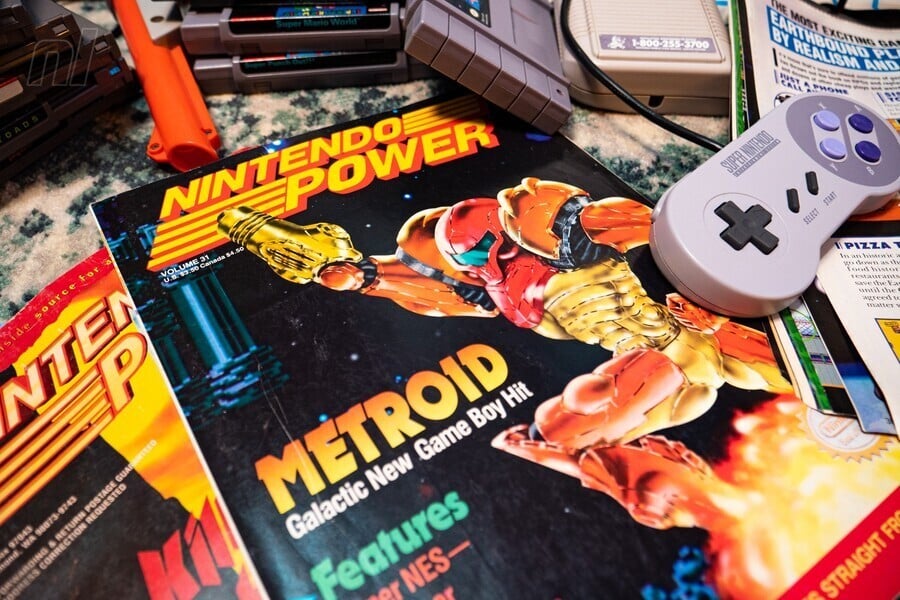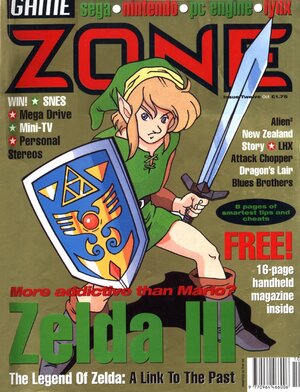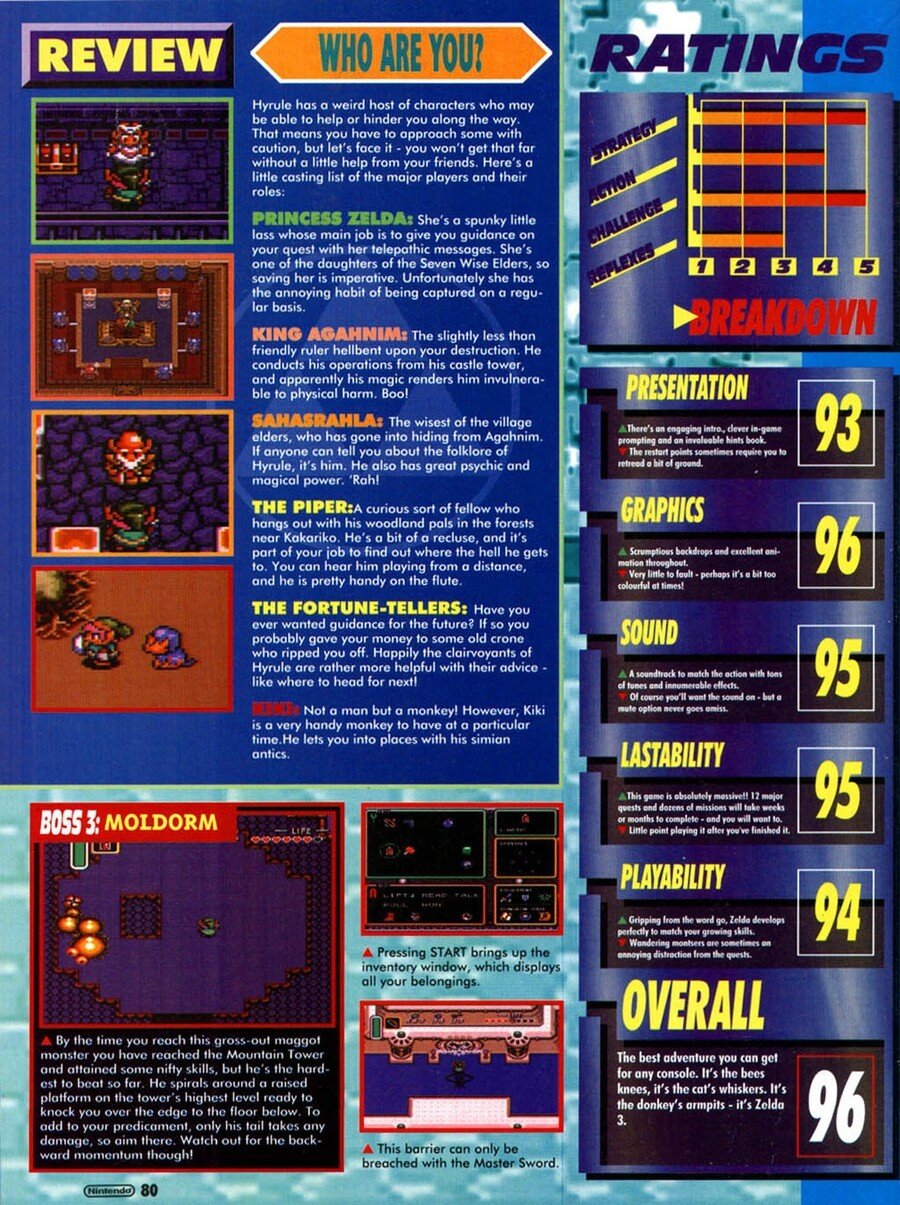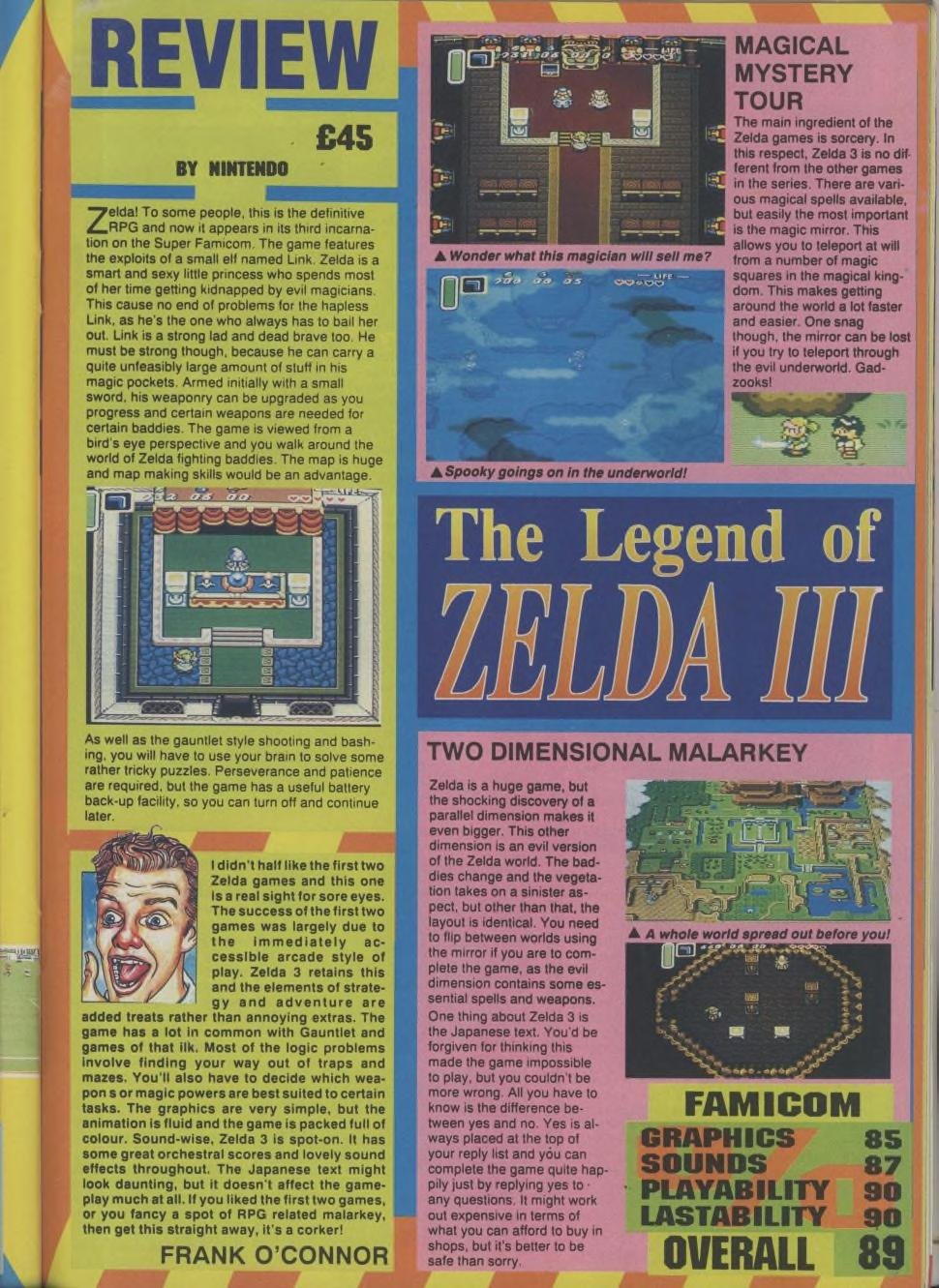Hot Zelda: Link To The Past Takes From ’90s Game Mags, 30 Years Later

Over the holidays we’re republishing some choice features from the last 12 months. A mix of talking points, interviews, opinion pieces and more from NL staff and contributors, you’ll find our usual blend of thoughtfulness, expertise, frivolity, retro nostalgia, and — of course — enthusiasm for all things Nintendo. Happy holidays!
Let us set the scene: The year is 1992. You are sitting in your living room, wearing something with massive shoulder pads, probably. Guns N’ Roses is playing on the radio. Social media does not yet exist.

It is into this peaceful scene that we can add a sprinkling of video game magazines, splashed with an egregious number of large, loud fonts, the interior full of game hint helplines and weirdly aggressive adverts. And, on the cover of one of the 1992 issues, a new game: The Legend of Zelda: A Link To The Past, the third in a series that has previously only been on the Nintendo Entertainment System.
This new game, though, promises more colours, more story, and unbeknownst to you, an entirely new world separate from the Hyrule you know and love. It’s the first time that a Zelda game would introduce the concept of a geographical and/or temporal dichotomy, but let’s be honest — it’s 1992, and you don’t know what any of those words mean. You’re just excited to get a new Zelda SNES game for your birthday, and we don’t blame you. Plus, the magazines say it’s really good.
And now, 30 years later (to the day!) we’ve combed through magazine archives to find a handful of those magazines, to examine what the gaming world was like back then — and how people really felt about A Link to the Past. It was only the third Zelda game, and although Zelda was obviously very popular, it wasn’t anything near to the cultural saturation of today, where a Zelda game can sell millions in its first week of release, and reduce grown men to fits of rage if it’s not quite what they want.
It’s fascinating not only to look back at the general perception of a game that would eventually make its way onto “greatest of all time” lists, but to see exactly what game critics felt was useful to their readers in 1992.
Nintendo Magazine System
Nintendo Magazine System, the British mag that would eventually become Official Nintendo Magazine (RIP), has a lot to say about the game in their walkthrough/hint guide/review:
“Zelda is excellent…. Buy it and you won’t regret it. What you will have is a game of enormous depth, excitement, even humour, but most of all quality. It’s the quality of design and implementation that is most striking about Zelda. The graphics are stunningly designed to appear 3-dimensional with brilliant colouring and the animation is wonderfully details: just witness lever-pulling or combat.
“Putting all the technical wizardry aside, Zelda most impresses me as a brilliantly thought out adventure. The puzzles are ingenious and challenging but never too obscure, and the feeling is that progress is always possible.
“This is one of the few games that rewards exploration, and there’s loads below the exterior still waiting to be discovered (by me!).”
– Gus
“It’s always difficult thinking of things to say about games which are virtually perfect… What impressed me most though was the tremendous degree of thought which has gone into the controls. There’s an absolute stack of objects to manipulate, people to talk to and actions to perform, and every last one is logically and friendlily managed.
“Anyone with the slightest inclination to investigate the role playing adventure genre should grab this one with both hands, and anyone who lacks that inclination needs their brains testing.”
-Jaz

Summary:
- Zelda: “A spunky little lass” who has “the annoying habit of being captured on a regular basis”
- Hyrule: “A square-shaped sort of country bounded by rocks”
- Graphics: “Scrumptious” with “excellent animation” but “perhaps…a bit too colourful at times”
- Responsiveness: “Excellent”
- Playability: “Gripping from the word go” but “wandering monsters are sometimes an annoying distraction”
- Lastability: “This game is absolutely massive…will takes weeks or months to complete”
- Difficulty: Medium/Hard
Nintendo Power
Nintendo Power’s coverage seemed to be mainly focused on how to play Link to the Past, and also spoiling all the cool secrets. But that’s just the thing — back then, talking about the cool powers you’d eventually get, like the ability to swim or cross over into the Dark World, were just tantalising reasons to buy and play the game. That wouldn’t fly today!
Nintendo Power also ran a LTTP comic for 12 issues alongside the release of the game, from January 1992 to December 1992. The series was illustrated by Shotaro Ishinomori — an influential manga artist who created many tokusatsu series, like the precursor to Power Rangers, Super Sentai, and the massively popular Kamen Rider. It’s a really cool video game relic, especially for someone who writes about Zelda as much as we do — there are tons of Link drawings in there that we’ve never seen before!
Although Nintendo Power’s coverage is a bit more “here’s a bombable wall” than “here’s what we think of this game”, there’s still some excellent prose to be found:
“A Link to the Past might be called the ultimate adventure. There is action for those players who love adventure, mysteries for those who love secrets, two worlds to explore and a story that ties it all together. The quest has just begun, although already it seems like it has been a long road.
Link’s path will pass through the seven levels of the Dark World and the Golden Pyramid. He will meet unlikely friends and face dangers in both the Light and Dark Worlds before hearing whispers of the dreaded name of Ganon.”
Holy Triforce, what an incredible way to describe the game! This makes us want to dig up our own copies and start the game all over again.
Computer and Video Games

“I didn’t half like the first two Zelda games,” says writer Frank O’Connor in a very British way of saying he did, in fact, very much like the first two Zelda games. “This one is a real sight for sore eyes.” He goes on to say that “Zelda III”, as they were calling it, retains the “immediately accessible arcade style of play” while introducing “elements of strategy and adventure”. It’s worth noting that CVG played the game on the Super Famicom in Japanese, which they say is “daunting” at first, but “all you have to know is the difference between yes and no.”
- Link: “A small elf” and a “strong lad” who is “dead brave”
- Zelda: “A smart and sexy little princess” (ew)
- Graphics: 85/100 — “very simple”
- Sounds: 87/100 — “spot-on”, whatever that means
- Playability: 90/100
- Lastability: 90/100
- Total score: 89/100
CVG’s review is a little muted, especially with the modern knowledge that “Zelda III” is considered a masterpiece, but we admire their work in getting the Japanese import to play early. The other thing about this review is that it’s almost comedically British ’90s stuff. Look:
“Zelda! To some people, this is the definitive RPG and now it appears in its third incarnation on the Super Famicom. The game features the exploits of a small elf named Link. Zelda is a smart and sexy little princess who spends most of her time getting kidnapped by evil magicians. This causes no end of problems for the hapless Link, as he’s the one who always has to bail her out.
Link is a strong lad and dead brave too. He must be strong though, because he can carry a quite unfeasibly large amount of stuff in his magic pockets…”
The review is a single page long, and they spend a good amount of time talking about Link’s inventory. We guess they couldn’t really talk about the story, though, since it was entirely in Japanese…
The Legend of Zelda: A Link to the Past – Nintendo Player’s Guide
It’s the early ’90s, and you can’t play a video game without a game guide. Whether you’ve spent hundreds of pounds/dollars/local currency on printer ink and dial-up internet costs to print off your own, or you’ve managed to convince your parents to spend their hard-earned cash on one of the bulky guides at the newsagents, it’s all the same — but this glossy, illustrated guide that’s official Nintendo (it even has the seal of quality!) is rather nice.
Plus, just like Nintendo Power, there are even more Zelda images that we’ve never seen before!
Super NES Buyers Guide
If you own a Super NES (or a SNES), you might want to know what’s worth buying. Trick question! The first thing you need to buy is a guide to buying, stupid!
A lot like Nintendo Power, the Super NES Buyers Guide is more of a “how to play” than an actual review, but it seems to give potential players the information they need (difficulty level, format, genre, etc.) and lets them decide for themselves. Not much of a buyers guide, though, is it? It’s basically just a back-of-the-box blurb, and we could have just, you know, looked at the back of the box. Ah well!
What a lovely trip down memory lane. Nothing shocking, of course — we were kind of hoping for some surprisingly negative review that we could laugh at with the benefit of hindsight, but of course everyone loved A Link to the Past. It’s not only a great game, but it was the blueprint for Zelda games from then on. We wouldn’t have Ocarina of Time or Breath of the Wild without ALTTP, let alone all the other brilliant, non-Zelda games that have been inspired by Link’s Dark World adventures since.
Happy 30th birthday, The Legend of Zelda: A Link To The Past. You changed the landscape of gaming forever, and we love you for it. And thanks for giving us a reason to read old games mags, too.
Give us your Link to the Past and games magazine memories in the comments below!











